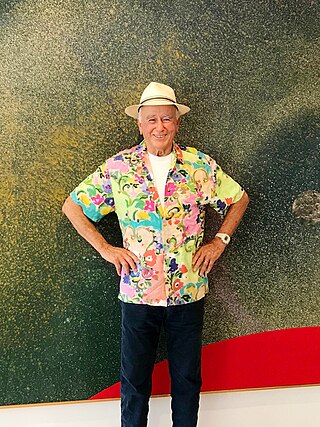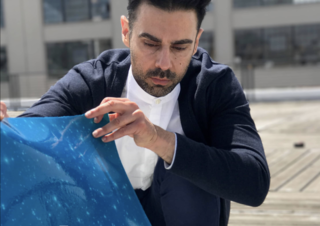Related Research Articles

Duane Hanson was an American artist and sculptor born in Minnesota. He spent most of his career in South Florida. He was known for his life-sized realistic sculptures of people. He cast the works based on human models in various materials, including polyester resin, fiberglass, Bondo, and bronze. Hanson's works are in the permanent collections of The Whitney Museum of American Art, The San Francisco Museum of Modern Art, and The Smithsonian.

Richard Diebenkorn was an American painter and printmaker. His early work is associated with abstract expressionism and the Bay Area Figurative Movement of the 1950s and 1960s. In the late 1960s he began his extensive series of geometric, lyrical abstract paintings. Known as the Ocean Park paintings, these paintings were instrumental to his achievement of worldwide acclaim.

Jay DeFeo was a visual artist who became celebrated in the 1950s as part of the spirited community of Beat artists, musicians, and poets in San Francisco. Best known for her monumental work The Rose, DeFeo produced courageously experimental works throughout her career, exhibiting what art critic Kenneth Baker called “fearlessness.”

Peter Voulkos was an American artist of Greek descent. He is known for his abstract expressionist ceramic sculptures, which crossed the traditional divide between ceramic crafts and fine art. He established the ceramics department at the Los Angeles County Art Institute and at UC Berkeley.

John Anthony Baldessari was an American conceptual artist known for his work featuring found photography and appropriated images. He lived and worked in Santa Monica and Venice, California.

James S. Strombotne is an American painter. He is known for his figurative work.
The Bay Area Figurative Movement was a mid-20th Century art movement made up of a group of artists in the San Francisco Bay Area who abandoned working in the prevailing style of Abstract Expressionism in favor of a return to figuration in painting during the 1950s and onward into the 1960s.

Manuel John Neri Jr. was an American sculptor who is recognized for his life-size figurative sculptures in plaster, bronze, and marble. In Neri's work with the figure, he conveys an emotional inner state that is revealed through body language and gesture. Since 1965 his studio was in Benicia, California; in 1981 he purchased a studio in Carrara, Italy, for working in marble. Over four decades, beginning in the early 1970s, Neri worked primarily with the same model, Mary Julia Klimenko, creating drawings and sculptures that merge contemporary concerns with Modernist sculptural forms.
Joe Goode is an American artist who attended the Chouinard Art Institute in Los Angeles from 1959–1961. Born in Oklahoma City, Oklahoma, Goode made a name for himself in Los Angeles through his cloud imagery and milk bottle paintings which were associated with the Pop Art movement. The artist is also closely associated with Light and Space, a West coast movement of the early 1960s. He currently creates and resides in Los Angeles, California.

Hans Gustav Burkhardt was a Swiss-American abstract expressionist artist.
Jim Goldberg is an American artist and photographer, whose work reflects long-term, in-depth collaborations with neglected, ignored, or otherwise outside-the-mainstream populations.

Billy Al Bengston was an American visual artist and sculptor who lived and worked in Venice, California, and Honolulu, Hawaii. Bengston was probably best known for work he created that reflected California's "Kustom" car and motorcycle culture. He pioneered the use of sprayed layers of automobile lacquer in fine art and often used colors that were psychedelic and shapes that were mandala-like. ARTnews referred to Bengston as a "giant of Los Angeles's postwar art scene."
Alwyn Walter "Walt" Peregoy was an American artist who was a color stylist and background artist for animated cartoons. Among the studios he worked for were Walt Disney Productions 1951–1964, 1974–1983, Format Films and Hanna-Barbera.
Ed Moses was an American artist based in Los Angeles and a central figure of postwar West Coast art.

Ala Ebtekar is a contemporary artist known primarily for his work in painting, drawing, illumination, and installation. His work frequently orchestrates various orbits and cadences of time, bringing forth sculptural and photographic possibilities of the universe, and time, gazing back at us.
Liz Larner is an American installation artist and sculptor living and working in Los Angeles.

Jack Hooper was an American painter, muralist, sculptor, printmaker and art educator. Hooper was a major figure on the Southern California art scene, belonging to that generation of Los Angeles painters who matured during the late 1950s and the 1960s, painters such as John Altoon, Sam Amato, Robert Irwin, Lee Mullican, William Brice and Billy Al Bengston. He was an innovator in the use of new materials, most importantly plastic in art. He is known for abstract expressionist, mural and figurative painting. Hooper has exhibited in art museums and galleries nationally and internationally including solo shows in Europe, Mexico and the United States. Modeling renown UCLA art professor and figurative artist, Jan Stussy, the last 20 years of his life were spent in rural Mexico, where he drew and painted every single day until his death.
Joe Doyle was an American artist. He is one of the original painters in the style, abstract illusionism, of the 1970s and has since evolved his style using computerized technologies to create Digital art.
Michael Frimkess is an American ceramic artist who lives in Venice, California. In the 1950s and 60s, he was a pupil of Peter Voulkos, a prominent figure in the California Clay Movement. Frimkess' pottery is noted for its classical style, employing forms from Greek, Chinese, and Indigenous American antiquity. His wife and collaborator, Magdalena Suarez Frimkess, paints his ceramic pieces, often using anachronistic, contemporary images like Minnie Mouse or Condorito. He is also well-known for his innovative wheel-throwing and firing techniques.
Jim Melchert was an American visual artist, arts administer, and professor. He known for his ceramics and sculptures. Melchert was part of the Funk art movement.
References
- ↑ "Tom Holland Art Exhibition At North Texas Gallery". cbslocal.com. 22 October 2013. Retrieved 23 August 2015.
- 1 2 . "Tom Holland", http://www.samuellynne.com/artist/tom-holland/
- 1 2 Ashbery, John (Mar 16, 1981). "Pleasures of Paperwork". Newsweek.
- ↑ Danieli, Nicholas (1969). "Wilder Gallery". The Los Angeles Times.
- ↑ . "ART IN REVIEW; Tom Holland", https://www.nytimes.com/2000/02/25/arts/art-in-review-tom-holland.html
- ↑ Muchnic, Suzanne (1982). "Corcoran Gallery show". The Los Angeles Times.
- ↑ Smith, Roberta (2000). "Art in Review". New York Times.
- ↑ Albright, Thomas (1981). "San Francisco: Different and Indifferent Drummies", 86-87. Published by ArtNews for the San Francisco Chronicle
- ↑ "James Corcoran Gallery". The Los Angeles Times. Aug 2, 1982.
- ↑ "Art Collection | CollectionSpace".
- ↑ "Untitled". 1970.
- ↑ "Ryder | LACMA Collections".
- ↑ "The Collection | MoMA".
- ↑ "Izio". 1984.
- ↑ "Luv".
- ↑ "Kama".
- ↑ "Tom Holland".
- ↑ "Tom Holland".